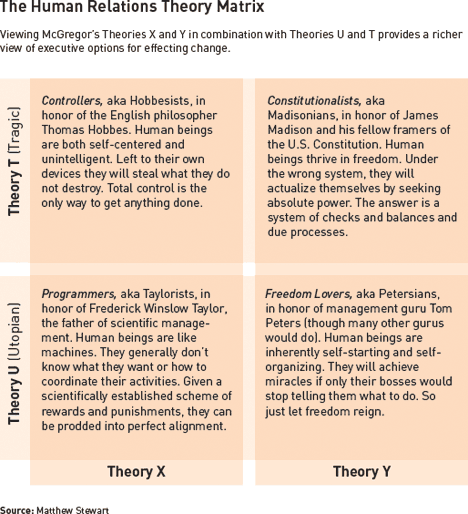Over at Strategy + Business, Matthew Stewart celebrates the 50th anniversary of Douglas McGregor's Theory X / Theory Y perspective on human nature in the context of managing people at work, which I think bears relevance to the present-day employee engagement fad.
Stewart suggests that "we're all Theory Y people now" - that we tend to favour employee freedom and self-realisation rather than autocratic command and control (a generalisation that perhaps doesn't apply outside some narrow cultural and geographic boundaries). It has been repackaged, he says, by many of the the big names of management 'wisdom' such as Tom Peters, Rosabeth Moss Kanter, and Charles Handy.
However, McGregor's theory of human nature has become confused with a theory of human conflict, says Stewart, who provides contrasting Utopian (U) and Tragic (T) theories of the latter to untangle the two kinds of theory. He puts the result, inevitably, into a 4x4 matrix:

He concludes that much of the debate about Theories X & Y has been a confusing one, between Controllers and Freedom Lovers, and has obscured the distinction of Theories U & T:
"If it requires a more thoughtful approach to management to accept that people are active by nature rather than passive, it requires a still more thoughtful approach to grapple with the fact that they can be active and destructive at the same time. Of the four types of managers in the Human Relations Theory Matrix, it is the constitutionalists who must expend the most mental energy and governance effort."
What does this mean for employee engagement?
Taking Stewart's matrix as a provocation for thought and conversation rather than a map of reality, I suppose one question is to consider if your particular flavour of employee engagement corresponds with the theories that your organisation (tacitly) adheres to. If not, does it illuminate any ways in which your engagement efforts are going mysteriously astray?
Secondly, if your approach to employee engagement sprawls across two or more of the four possibilities conceived by Stewart, perhaps that's either a sign of enlightened postmodern complexity reflecting your organisation - or just a bit of a mess. Does that matter?
12 October 2010
Employee engagement - theories X, Y, U & T
Posted by
Andrew
at
Tuesday, October 12, 2010
![]()
Subscribe to:
Post Comments (Atom)

No comments:
Post a Comment